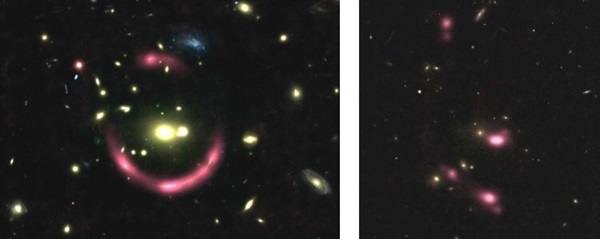Astronomers peer at the glowing shrouds of gas around distant galaxies – Astronomy Magazine
These two Hubble images show gravitationally lensed galaxies and their halos (pink), as well as the galaxy clusters (yellow) responsible for the lensing. Gravitational lensing often results in more than one image of a single galaxy (right), or sometimes smears that light out into a ring (left).
ESO/NASA/ESA/A.Claeyssens
Two new images showing these glowing halos of gas have been released as part of a study presented June 25 during the annual meeting of the European Astronomical Society by Adélaïde Claeyssens of the Centre de Recherche Astrophysique de Lyon. These images, taken with the Hubble Space Telescope, show gravitationally lensed galaxies and their, in this case, easy-to-spot halos. Gravitational lensing occurs when a massive object, such as a galaxy cluster, sits between another object — say, a single galaxy — and Earth. Einstein’s theory of general relativity states that the gravity of a massive object — the cluster — bends space-time around it. When light from the background galaxy encounters this bent space-time, it curves around the cluster, allowing us to see the faraway object.
That light is often not only bent but magnified as well, giving astronomers an intimate peek at details normally invisible in objects so very far away. It is this effect that Claeyssens’ survey uses to its advantage, pointing MUSE at these magnified galaxies to glean information otherwise impossible to get.






